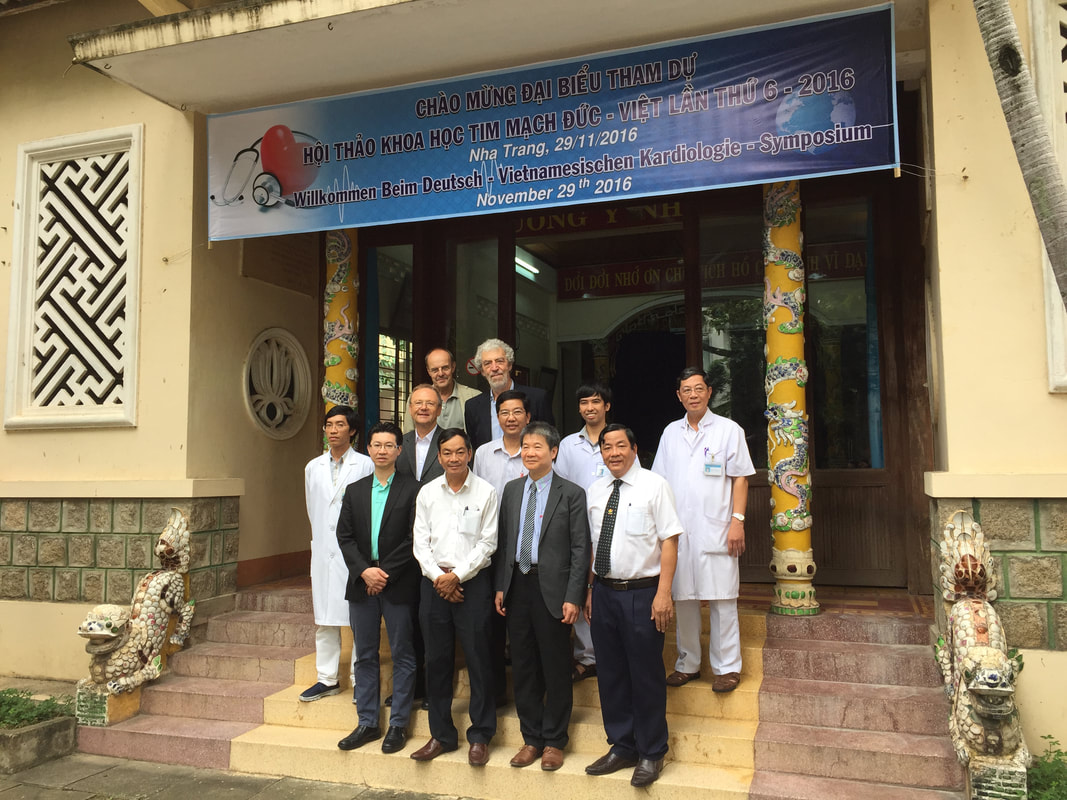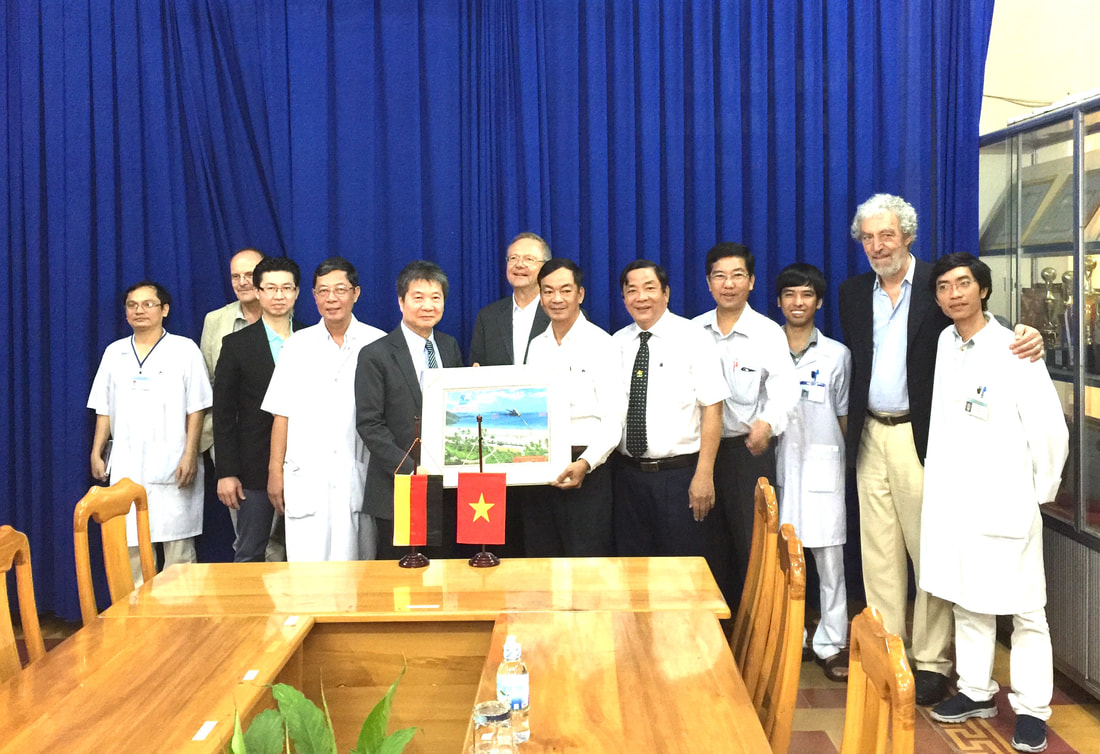|
6. VIETNAMESE GERMAN SCIENTIFIC SYMPOSIUM NHA TRANG
29.11.2016 Venue: General Hospital Khanh Hoa Times: 14:00 -17:00 Organization: General Hospital Khanh Hoa in Cooperation with
Lectures: Atrial Fibrillation - Update 2016: New Guidelines, Ablative Treatment, Drugs, Studies Dr. Dinh Quang Nguyen, Medical Clinic III, Department of Cardiology, St. Vinzenz-Hospital, Cologne, Germany Ventricular Tachycardia - Update 2016: Guidelines, Ablative Treatment, Drugs, Studies Dr. Dinh Quang Nguyen, Medical Clinic III, Department of Cardiology, St. Vinzenz-Hospital, Cologne, Germany Antitcoagulation and Antithrombotic Therapy in Patients with Atrial Fibrillation (AF) and Acute Coronary Syndrome – Update 2016 Prof. Dr. Hans-F. Voehringer, Clinical Research Centre, DRK Kliniken I Koepenick, Germany Transradial vs. transfemoral access in patients with ACS: Bleeding complications and Outcome Dr. Ralph Schoeller (on behalf of Berlin Myocardial Infarction Registry), Clinic for Cardiology of DRK Kliniken Berlin I Westend, Germany Cardiac Rehabilitation – Update 2016 Günter Haug, M.D., FESC , Rehabilitation Center, German Pension Insurance Federation, Bayerisch Gmain, Germany Non-invasive positive pressure ventilation for the treatment of chronic obstructive pulmonary disease (COPD) - Update 2016 Prof. Dr. Si Huyen Nguyen, Vietnamese German Faculty of Medicine at Pham Ngoc Thach University of Medicine HCMC, HELIOS St. Marienberg Hospital Helmstedt, Academic Hospital of the Otto-von-Guericke University Magdeburg, Germany FACULTY: Dr. Günter Haug, FESC , Rehabilitation Center, German Pension Insurance Federation, Bayerisch Gmain, Germany Dr. Dinh Quang Nguyen, Medical Clinic III, Department of Cardiology, St. Vinzenz-Hospital, Köln, Germany Prof. Dr. Si Huyen Nguyen, Vietnamese German Faculty of Medicine at Pham Ngoc Thach University of Medicine HCMC, HELIOS St. Marienberg Hospital Helmstedt, Academic Hospital of the Otto-von-Guericke University Magdeburg, Germany Dr. Ralph Schoeller, Clinic for Cardiology of DRK Kliniken Berlin I Westend, Germany Prof. Dr. Hans-F. Voehringer, Clinical Research Centre, DRK Kliniken I Koepenick, Germany
0 Comments
16. VIETNAMESE GERMAN HEART DAYS 2016
SCIENTIFIC SYMPOSIUM HCMC 27.11.2016 Organization: Vietnamese Heart Association of Ho Chi Minh City in Cooperation with
Lectures: Atrial Fibrillation - Update 2016: New Guidelines, Ablative Treatment, Drugs, Studies Dr. Dinh Quang Nguyen, Medical Clinic III, Department of Cardiology, St. Vinzenz-Hospital, Cologne, Germany Summary:
Ventricular Tachycardia - Update 2016: Guidelines, Ablative Treatment, Drugs, Studies Dr. Dinh Quang Nguyen, Medical Clinic III, Department of Cardiology, St. Vinzenz-Hospital, Cologne, Germany Summary:
Antitcoagulation and Antithrombotic Therapy in Patients with Atrial Fibrillation (AF) and Acute Coronary Syndrome – Update 2016 Prof. Dr. Hans-F. Voehringer, Clinical Research Centre, DRK Kliniken I Koepenick, Germany Background: Guidelines for treatment of atrial fibrillation (AF) and coronary revascularisation recommend individual treatment regimen for patients with AF and acute coronary syndrome (ACS) according to their risk of bleeding or suffering from thrombo-embolic complications. The aim of the present study is to illustrate how guidelines are implemented into daily practice and whether treatment approaches have changed over time since the introduction of new oral anticoagulants (NOACs). Methods and Results: From January 2011 to December 2014 we included 1537 AF patients with ACS into a registry (Berlin Myocardial Infarction Registry) collecting data on hospital treatment, hospital mortality, and discharge medication. 790 out of these patients received DES (51.4%), 277 BMS (18%), 125 only balloon dilatation (8.1%) and 345 no intervention (22.4%), respectively. 95 % of patients had a CHA2DS2-VASc Score >1, the hospital mortality amounted to 9.8%. Table 1: Anticoagulation for AF patients with ACS discharged from hospital with CHA2DS2-VASc Score >1 Table 2: Discharge medication for patients treated with stents dismissed from hospital with CHA2DS2-VASc Score >1 Conclusion: In Tab 1 and 2 the percentage of patients treated with anticoagulation is seen over a time period of 4 years. While the percentage of patients treated with heparin and Vitamin-K antagonists has remained the same, those patients treated with NOACs have increased. Nearly 60% of AF patients with ACS received a triple therapy. The findings will be discussed in light of published data in the literature. Newer and specifically designed trials are awaited for further improvement of the existing knowledge about efficacy and safety of this combination therapy. Transradial vs. transfemoral access in patients with ACS: Bleeding complications and Outcome Dr. Ralph Schoeller (on behalf of Berlin Myocardial Infarction Registry), Clinic for Cardiology of DRK Kliniken Berlin I Westend, Germany Background: The use of transradial access for PCI is growing and the newly published guidelines on treatment of ACS take account of this, provided the necessary experience exists. We studied ways of access in treatment of ACS patients under real world conditions in a big city. Methods: Our Registry collects data on hospital treatment of patients with ACS since 1999. Since 1.4.2011 data on different ways of PCI access are collected. In our study we included all 10,146 patients treated with PCI from 20 hospitals between 1.4.11-31.12.14. We studied bleeding complications according to GUSTO criteria (mild, moderate, severe) and we analysed the influence of transfemoral vs. transradial access on hospital mortality. Results: 4165 patients were treated with transradial (41,1%), 5981 with transfemoral (58,9%) PCI access. Transfemoral vs. transradial access influences hospital mortality (OR=1.53; 95% CI: 1.18–1.98) and also influences chances of moderate to severe bleeding (OR=1.69; 95% CI: 1.17–2.45) even after adjustment for differences in patient characteristics and in antiplatelet and antithrombotic therapy. Table: Differences between patients with transradial vs. transfemoral access Conclusion:
Cardiac Rehabilitation – Update 2016 Günter Haug, M.D., FESC , Rehabilitation Center, German Pension Insurance Federation, Bayerisch Gmain, Germany The aim of this lecture is to give an update 2016 of cardiac rehabilitation (rehab) according to international guidelines (AHA, AAVPR, EAPR of ESC) focussed on strategies how to organize modern cardiac rehab. Class I indications for post-surgical and post-interventional referral and logistic feasibilities to transfer these eligible patients to in-patient resident or out-patient cardiac rehab units will be presented. Evidence based benefits and safety as well as concerns and risks of early and continued cardiac rehab are described. Based on our experience out of a 230-bed cardiac rehabilitation center overlooking more than 3000 in-patient rehab cases a year we discuss requirements for structures, core competencies of staff and core components of cardiac rehab in the different phases of recovery. Guideline based programs covering the 5 core components of cardiac rehab, in particular supervised exercise training, patient education on specific heart condition of cardiovascular diseases (CVD) as well as strategies to improve risk factors and to stop smoking, to achieve medication adherence and emotional recovery will be presented. We therefore demonstrate in particular rehab specific medical admission, rehabilitation care, risk stratification, prescription of supervised exercise training, courses to improve risk factors considering country specific needs as well as to achieve medication adherence. The objectives of early and continued cardiac rehab are to overcome postoperative and post-interventional physical and functional handicaps, to avoid early complications, further cardiac events and progression of CVD, to cope with psychosocial problems, and to reintegrate in job and family. In summery core components of modern cardiac rehabilitation will be presented based on our specific experience and according to latest study results and current guidelines. Roadmaps how to organize cardiac rehab in order to improve early and long-term outcome and last but not least in order to discharge acute hospital wards, to raise the number of operations and interventions, and therefore to increase the number of treatable patients esp. in low-resource settings will be discussed. Non-invasive positive pressure ventilation for the treatment of chronic obstructive pulmonary disease (COPD) - Update 2016 Prof. Dr. Si Huyen Nguyen, Vietnamese German Faculty of Medicine at Pham Ngoc Thach University of Medicine HCMC, HELIOS St. Marienberg Hospital Helmstedt, Academic Hospital of the Otto-von-Guericke University Magdeburg, Germany The non-invasive ventilation (NIV) has been established for about 20 years as a successful treatment method for acute respiratory insufficiency (ARI), as home ventilation it has been used in the last 10 years by hypercapnic COPD patients increasingly. A persistent hypercapnia for medically treated patients with COPD is a manifest sign of the failure of the respiratory pump and thus indicates a poor prognosis of the disease. It is also regarded as a criterion for initiating nocturnal home ventilation with a non-invasive, pressure-controlled ventilation (NPPV). This measure is primarily to improve the quality of life. In a recently published study by Köhnlein et al a relevant life extension by NPPV has now been documented in patients with a chronic failure of the respiratory pump in COPD for the first time. The pathophysiology of COPD, indications and contraindications for NIV in ARI and nocturnal home ventilation, techniques and practical application of non-invasive ventilation are presented. FACULTY: Dr. Günter Haug, FESC , Rehabilitation Center, German Pension Insurance Federation, Bayerisch Gmain, Germany Dr. Dinh Quang Nguyen, Medical Clinic III, Department of Cardiology, St. Vinzenz-Hospital, Köln, Germany Prof. Dr. Si Huyen Nguyen, Vietnamese German Faculty of Medicine at Pham Ngoc Thach University of Medicine HCMC, HELIOS St. Marienberg Hospital Helmstedt, Academic Hospital of the Otto-von-Guericke University Magdeburg, Germany Dr. Ralph Schoeller, Clinic for Cardiology of DRK Kliniken Berlin I Westend, Germany Prof. Dr. Hans-F. Voehringer, Clinical Research Centre, DRK Kliniken I Koepenick, Germany |
Archiv
November 2019
|


 RSS Feed
RSS Feed
